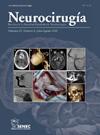脊柱机器人手术:最初40例的技术说明和描述性分析
IF 0.8
4区 医学
Q4 NEUROSCIENCES
引用次数: 0
摘要
由于人口的逐渐老龄化和预期寿命的增加,全球脊柱病理的发病率正在增加。椎体经椎弓根螺钉固定是不稳定或潜在不稳定病变中最常用的技术。有不同的植入方法,最近发展的是由机器人导航引导的植入。材料和方法我们描述了ExcelsiusGPS®机器人导航系统(GlobusMedical, Inc ., Audubon, PA, USA)的技术方面和不同的工作流程,以及2023年7月至2024年2月期间在拉巴斯大学医院接受手术的前40名患者的结果。结果在胸椎和腰椎共植入螺钉250枚。微创手术(MIS) 12例(30%),开放手术28例(70%)。每位患者植入螺钉的中位数为6.00(4.00-6.00)。术中移位率为2.5%(1例)。手术时间中位数为143.00分钟(113.00-165.50分钟)。住院时间中位数为4.00天(3.00-5.50天)。术中放射量中位数为899 mGy/cm2(523.25-1595.00)。中位失血量为150.00 ml(100.00 ~ 300.00),输血率为0%。与传统技术相比,机器人脊柱手术的准确率提高到96% -100%,并减少了患者和手术团队接受的辐射剂量。此外,它允许植入更大的螺钉,这与增加的生物力学强度和降低松动的风险有关。最初,它可能会增加总手术时间,但一旦达到学习曲线,这就会减少,大约40例。sexcelsiusgps®是市场上最新的机器人模型,不同的研究已经证明了它在不同技术和适应症中的有效性。与其他专门用于背腰椎病理的机器人系统不同,它可以用于整个脊柱轴的病理(从C1到骶骨)和脑病理(深部电极植入,脑活检,SEEG等)。本文章由计算机程序翻译,如有差异,请以英文原文为准。
Cirugía robótica de columna vertebral: nota técnica y análisis descriptivo de los primeros 40 casos
Introduction
The global incidence of spinal pathology is increasing due to the progressive aging of the population and increased life expectancy. Vertebral fixation with transpedicular screws is the most commonly used technique in unstable or potentially unstable pathologies. There are different implantation methods, the most recently developed being implantation guided by robotic navigation.
Materials and methods
We describe the technical aspects and the different workflows available with the ExcelsiusGPS® robotic navigation system (GlobusMedical, Inc, Audubon, PA, USA), as well as the results of the first 40 patients operated on at the Hospital Universitario La Paz between July 2023 and February 2024.
Results
A total of 250 screws were implanted at the thoracic and lumbar levels. Twelve patients underwent minimally invasive surgery (MIS) (30%) and 28 patients underwent open surgery (70%). The median number of screws implanted per patient was 6.00 (4.00-6.00). The intraoperative malpositioning rate was 2.5% (1 case). The median duration of surgery was 143.00 minutes (113.00-165.50). The median hospital stay was 4.00 days (3.00-5.50). The median intraoperative radiation delivered was 899 mGy/cm2 (523.25-1595.00). The median blood loss was 150.00 ml (100.00-300.00) and the blood transfusion rate was 0%.
Discussion
Compared to conventional techniques, robotic spine surgery increases accuracy to 96-100% and reduces the radiation dose received by the patient and surgical team. In addition, it allows the implantation of larger screws, which has been associated with increased biomechanical strength and reduced risk of loosening. Initially, it may involve an increase in total surgical time, but this is reduced once the learning curve is reached, around 40 cases.
Conclusions
ExcelsiusGPS® is the most recent robot model on the market and different studies have demonstrated its effectiveness in different techniques and indications. Unlike other robotic systems used exclusively in dorsolumbar spine pathology, it can be used in the pathology of the entire spinal axis (from C1 to the sacrum) and brain pathology (deep electrode implantation, brain biopsy, SEEG, among others).
求助全文
通过发布文献求助,成功后即可免费获取论文全文。
去求助
来源期刊

Neurocirugia
医学-神经科学
CiteScore
1.30
自引率
0.00%
发文量
67
审稿时长
60 days
期刊介绍:
Neurocirugía is the official Journal of the Spanish Society of Neurosurgery (SENEC). It is published every 2 months (6 issues per year). Neurocirugía will consider for publication, original clinical and experimental scientific works associated with neurosurgery and other related neurological sciences.
All manuscripts are submitted for review by experts in the field (peer review) and are carried out anonymously (double blind). The Journal accepts works written in Spanish or English.
 求助内容:
求助内容: 应助结果提醒方式:
应助结果提醒方式:


